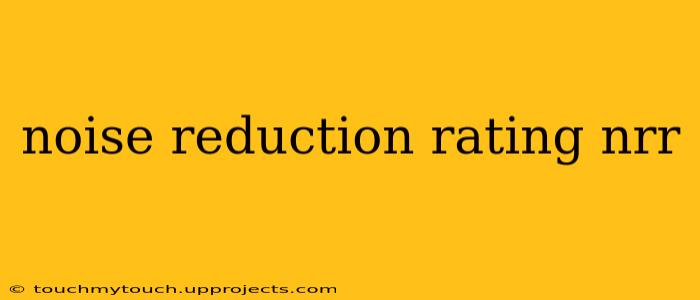Hearing loss is a serious concern, affecting millions worldwide. Prolonged exposure to loud noises can cause irreversible damage, impacting your quality of life. This is why understanding and selecting appropriate hearing protection is crucial. A key factor in choosing the right protection is the Noise Reduction Rating (NRR). This article will delve into what NRR means, how it's measured, its limitations, and how to select the best hearing protection for your needs.
What is the Noise Reduction Rating (NRR)?
The Noise Reduction Rating (NRR) is a single-number rating assigned to hearing protectors (earplugs and earmuffs) by the US Environmental Protection Agency (EPA). This rating indicates the amount of noise reduction the protector can provide, expressed in decibels (dB). A higher NRR signifies greater noise reduction potential. For example, an earplug with an NRR of 33 dB will theoretically reduce noise exposure by 33 dB.
How is NRR Measured?
The NRR isn't measured in a real-world setting on individual users. Instead, it's determined through laboratory testing using standardized procedures. These tests involve placing the hearing protector on a group of subjects, exposing them to various noises, and measuring the amount of noise reduction achieved. The NRR is then calculated based on the average reduction across all subjects.
Understanding the Importance of Standardized Testing
The standardized testing methodology ensures consistency and allows for comparisons between different hearing protection products. Without these standardized tests, it would be impossible to accurately compare the effectiveness of different earplugs or earmuffs.
Limitations of the NRR
While the NRR is a helpful guide, it's crucial to understand its limitations:
- Individual Variation: The NRR represents an average reduction. Individual experiences can vary due to factors like proper fitting, ear shape, and user habits. A poorly fitted earplug, for example, will provide significantly less noise reduction than advertised.
- Real-world Conditions: Laboratory tests don't replicate all real-world scenarios. Factors like temperature, humidity, and the type of noise encountered can influence the actual noise reduction achieved.
- NRR is a Minimum: The NRR is considered a minimum reduction level. You can expect at least that level of protection, but the actual reduction could be higher.
Choosing the Right Hearing Protection Based on NRR
Selecting hearing protection involves considering several factors, not just the NRR. Here's a breakdown:
- Workplace Environment: Determine the noise levels in your work environment. A professional noise assessment is recommended for accurate measurement.
- Type of Hearing Protection: Earplugs and earmuffs offer different levels of comfort, fit, and noise reduction. Earmuffs generally offer a higher NRR than earplugs.
- Fit and Comfort: Proper fit is paramount. Uncomfortable hearing protection won't be worn consistently, negating its protective value. Experiment with different styles and sizes to find the most comfortable and secure fit.
- Additional Factors: Consider factors like durability, reusability, and cost-effectiveness. Some disposable earplugs are more cost-effective for single-use situations.
Beyond the NRR: Other Considerations
While the NRR is essential, it's not the only factor to consider when choosing hearing protection. Look for products that:
- Are comfortable and easy to use: Compliance is key.
- Provide a good seal: A proper seal is crucial for effective noise reduction.
- Meet or exceed relevant safety standards: Ensure the product complies with standards set by organizations like ANSI (American National Standards Institute).
Conclusion
The Noise Reduction Rating (NRR) is a valuable tool for selecting hearing protection, but it’s not the whole story. By understanding its limitations and considering individual factors such as fit and the work environment, you can make informed decisions to protect your hearing effectively. Always prioritize comfort and a secure fit to maximize the benefit of your chosen hearing protection. Remember to consult with a hearing professional or occupational health specialist for personalized advice on hearing protection.
